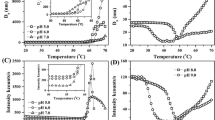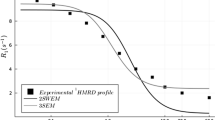Abstract
Live cells contain high concentrations of macromolecules, but almost all experimental biochemical data have been generated from dilute solutions that do not reflect conditions in vivo. To understand biomolecular behavior in vivo, properties studied in vitro are extrapolated to conditions in vivo. Another significant factor which is overlooked is the effects of macromolecular crowding and its consequences in the actual biochemical and physiological environment. Such influences of crowding, its modification and physiological parameters have been reported. The present study investigates the effect of molecular crowding on binding characteristics of Salmon sperm DNA with Bovine hemoglobin and their reconstitutes in presence of molecular crowders viz., Poly ethylene glycol (PEG) and Dextran of different molecular weight by fluorescence, UV visible spectroscopic technique at different temperatures. The results showed that BHb fluorescence was quenched by sDNA through static quenching mechanism which is enhanced in presence of polymers. The number of binding sites ‘n’ and binding constants ‘K’ were determined at different temperatures based on fluorescence quenching. The thermodynamic parameters namely ∆H°, ∆G°, T∆S° were studied at different temperatures and the results indicate that hydrophobic forces are predominant in the sDNA-BHb complex. Negative ∆G° values imply that the binding process is spontaneous.





Similar content being viewed by others
Abbreviations
- sDNA:
-
Salmon sperm deoxyribose nucleic acid
- BHb:
-
Bovine hemoglobin
- PEG:
-
Poly ethylene glycol
- PBS:
-
Phosphate buffered saline
- EtBr:
-
Ethidium bromide
References
Nakano S, Miyoshi D, Sugimoto N (2014) Effects of molecular crowding on the structures, interactions, and functions of nucleic acids. Chem Rev 114:2733–2758
Ellis RJ (2001) Macromolecular crowding: obvious but underappreciated. Trends Biochem Sci 26:597–604
Minton AP (2001) The influence of macromolecular crowding and macromolecular confinement on biochemical reactions in physiological media. J Biol Chem 276:10577–10580
Zimmerman SB, Minton AP (1993) Macromolecular crowding: biophysical, biochemical, and physiological consequences. Annu Rev Biophys Biomol Struct 22:27–65
Minton AP (2006) How can biochemical reactions within cells differ from those in test tubes? J Cell Sci 119:2863–9
Zimmerman SB (1993) Macromolecular crowding effects on macromolecular interactions: some implications for genome structure and function. Biochim Biophys Acta 1216(2):175–85
Zimmerman SB, Harrison B (1987) Macromolecular crowding increases binding of DNA polymerase to DNA: an adaptive effect. Proc Natl Acad Sci U S A 84(7):1871–5
Tateishi-Karimata H, Nakano S, Sugimoto N (2013) Quantitative analyses of nucleic acid stability under the molecular crowding condition induced by cosolutes. Curr Protoc Nucleic Acid Chem 53:7.19.1–7.19.17
Pal PD, Dongre PM, Chitre AV (2014) “Is macromolecular crowding overlooked?” - effectsof volume exclusion on DNA-amino acids complexes and their reconstitute received. J Fluoresc 24:1275–1284
Kong L, Liu Z, Hu X, Liu S, Meng J (2013) Spectroscopic study on interaction between bovine hemoglobin and salmon DNA and the analytical applications. J Lumin 137:186–190
Pal P, Dongre PM, Chitre AV (2013) Is DNA crowded by macro-neighbours? Int J Chem 2(1):25–32
Olins DE, Olws AL, Von Hippel PH (1967) Model nucleoprotein complexes: studies on the interaction of cationic homopolypeptides with DNA. J Mol Biol 24:157–176
Peacocke AR, Skerrett JNH (1956) The interaction of aminoacridines with nucleic acids. Trans Faraday Soc 52:261–79
Lakowicz JR (1999) Principle of fluorescence spectroscopy, 3rd edn. Springer, New York
Kandagal PB, Shaikh SMT, Manjunatha DH, Seetharamappa J, Nagaralli BS (2007) Spectroscopic studies on the binding of bioactive phenothiazine compounds to human serum albumin. J Photochem Photobiol A: Chem 189(1):121–127
Mahato M, Pal P, Tah B, Ghosh M, Talapatra GB (2011) Study of silver nanoparticle–hemoglobin interaction and composite formation. Colloids Surf B: Biointerfaces 88:141–149
Giovannetti R (2012) The use of Spectrophotometry UV–Vis for the study of porphyrins, macro to nano spectroscopy, Dr. Jamal Uddin (Ed.), InTech
O’dell K, Shell E (2007) Crowding effects on hemoglobin stability. FASEB J 21:648.6
Sasahara K, McPhie P, Minton AP (2003) Effect of dextran on protein stability and conformation attributed to macromolecular crowding. J Mol Biol 326(4):1227–37
Lodish H, Berk A, Zipursky SL et al (2000) Molecular cell biology, 4th edn. W. H. Freeman, New York
Acknowledgments
We gratefully acknowledge the Department of Science and Technology (DST), Government of India, for their financial support through the DST INSPIRE - AORC scheme.
Author information
Authors and Affiliations
Corresponding author
Rights and permissions
About this article
Cite this article
Pal, P.D., Dongre, P.M. & Chitre, A.V. Implications of Volume Exclusion: A Look at Thermodynamic Perspective of DNA-Hemoglobin Complexes and Their Reconstitutes Under Macromolecular Crowding. J Fluoresc 26, 355–362 (2016). https://doi.org/10.1007/s10895-015-1721-z
Received:
Accepted:
Published:
Issue Date:
DOI: https://doi.org/10.1007/s10895-015-1721-z




